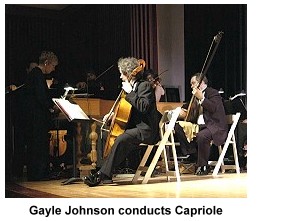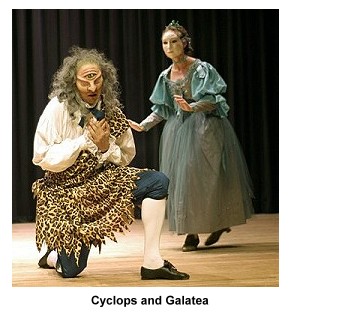
ReviewsCapriole's Splendid ReturnThe lighting on the musicians was perfect on the stage, creating an ambiance of some 300 years ago when candle light would give a luminous glow to an evening of musical theatre. Here, it helped set the stage for the grandeur of the court of Louis XIV in France, where Louis danced the role of Apollo in a spectacle of the sun rising after a long night. Seeing Capriole, the professional baroque group, on stage again, was very much a resurrection.
We recall when Capriole was at William and Mary in Williamsburg - a natural fit for music that was contemporary when the town was begun. Later they moved to ODU and filled Chandler Hall with their wonderful sounds, and then came the tragedy. But Gayle Johnson, who founded Capriole in 1979, did not give up. With true determination and a grant from the Virginia Commission for the Arts and some funds from Virginia Beach, the group returned to the stage at the Contemporary Art Center in Virginia Beach on September 8, 2003. The Phoenix Rises was the very appropriate title of this program of Baroque and Renaissance music and dance. From the harpsichord, Gayle Johnson directed twelve musicians in Come Ye Sons of Art, from the Birthday Ode to Queen Mary of 1694. They played period instruments in a style that would have been familiar to the composer of the piece, Englishman Henry Purcell (1659-1695). The gut-stringed instruments have a mellow sound and the trumpets have a less predictable sound with an edge. It was all quite wonderful.
Mr. Baird, as Apollo, opened the second half. He was costumed as Louis XIV might have been in 1653 when he danced the role. He later adopted the soubriquet "The Sun King." The ostrich plumes on the hat were two feet tall with spikes of sun rays all over the costume, even on the buckles of the shoes. This music, also by Lully, was lively and well played. The program closed with Purcell's music for Act IV from the Fairy Queen, which featured vocal soloists soprano Amanda Balestieri, countertenor Steven Rickards, tenor Robert Petillo and bass Christopher Bolduc and the Capriole Boychoir. These five young voices added to the richness of the experience of hearing this music composed as an embellishment of a new production of Shakespeare's Midsummer Night's Dream, inserted as scenes within the play. Each singer became one of the seasons paying homage to Phoebus, god of the sun, "with an undeniable parallel to the musical homage paid to Louis XIV as Sun King" which was common in French opera of that time. (From the program notes). The first dancing is again by the sun king, here to honor King Oberon; the duet of tenor and countertenor celebrates the occasion. The tenor as Phoebus sings of banishing cold winter. The female dancer is Spring with the vocals done by the soprano, whose gorgeous fluid tone and excellent breath control make her an ideal Baroque singer. Countertenor Steven Rickards dances with Ms. Whitley-Bauguess as Spring, as he sings the song of Summer. Rickards is this reviewer's favorite countertenor because of his natural, unforced sound. The tenor sings Autumn and the bass sings Winter while Ms. Whitley-Bauguess dances. The chorus ends with the principal singers and Boychoir joining the instrumentalists in a celebration in glorious sound. The boychoir was extremely well trained but they need more stage experience - I plan to be there the hear them - synchronized bows aren't quite possible yet! After three and a half years of silence, Capriole is returning from a devastating embezzlement which nearly forced it into bankruptcy. Acclaimed internationally for the vibrancy of its performances and based in Tidewater Virginia since 1987, Capriole specializes in theatrical music of seventeenth-century England, Italy and France. Ms. Johnson founded Capriole in 1979 with a concert by seventeenth-century Venetian composer, Claudio Monteverdi. Ironically, Capriolešs last concert before the embezzlement was detected and operations were shut down, was also a concert of music by Monteverdi. "The music of Monteverdi was the reason I turned to the performance of early music," says Ms. Johnson. "I was a theory major at Oberlin Conservatory and my Renaissance counterpoint class ended with an in-depth study of Monteverdišs Vespers. I had never experienced music of such emotional power. If I were stranded on an island and could only have one CD in my portable CD player, it would be Monteverdi's 1610 Vespers." Under her leadership, Capriolešs performances have received critical acclaim on both sides of the Atlantic and Ms. Johnson has been in Who's Who since 1995. A graduate of both Oberlin College and Oberlin Conservatory, Ms. Johnson is an enthusiastic teacher of all ages and recently taught an enthusiastically received class for ODU's Institute for Learning in Retirement. Capriole has received accolades on both sides of the Atlantic and its musicians are among the best in their field, specialists in early music who regularly perform with the finest early music ensembles. Favorite Capriole singers mezzo soprano Barbara Hollinshead and countertenor Steven Rickards return, as do baroque dancers Paige Whitley Bauguess and Thomas Baird, widely recognized as the best baroque dancers in the world. The Virginia Arts Commission has expressed its confidence in the group by awarding a grant for this concert, commenting that Capriole is "A top notch performing ensemble, with wonderful performances and real musicianship... unique in the area." |
 Founder and artistic director Gayle Johnson has worked
very hard to recreate the Capriole after an embezzler bankrupted the group three years ago.
Founder and artistic director Gayle Johnson has worked
very hard to recreate the Capriole after an embezzler bankrupted the group three years ago. Jean-Baptiste
Lully's (1632-1687) Acis and Galatea was first performed
in 1686. The dancers, Paige Whitley-Bauguess and Thomas Baird, in
their period finery, recreated steps passed down in the form of
dance notations and in dancing manuals, along with their own choreographies
in Baroque style, to tell the tragic, mythological story. The sea
nymph, Galatea, is loved by both prince Acis and the cyclops, Polyphemus,
who is jealous of Galatea's attentions to Acis and crushes him.
As his blood flows in the river she dives into the water and they
are reunited forever. High drama, indeed, and the music wonderfully
well played by the group. At intermission refreshments were served
in the Atrium of the CAC building.
Jean-Baptiste
Lully's (1632-1687) Acis and Galatea was first performed
in 1686. The dancers, Paige Whitley-Bauguess and Thomas Baird, in
their period finery, recreated steps passed down in the form of
dance notations and in dancing manuals, along with their own choreographies
in Baroque style, to tell the tragic, mythological story. The sea
nymph, Galatea, is loved by both prince Acis and the cyclops, Polyphemus,
who is jealous of Galatea's attentions to Acis and crushes him.
As his blood flows in the river she dives into the water and they
are reunited forever. High drama, indeed, and the music wonderfully
well played by the group. At intermission refreshments were served
in the Atrium of the CAC building.